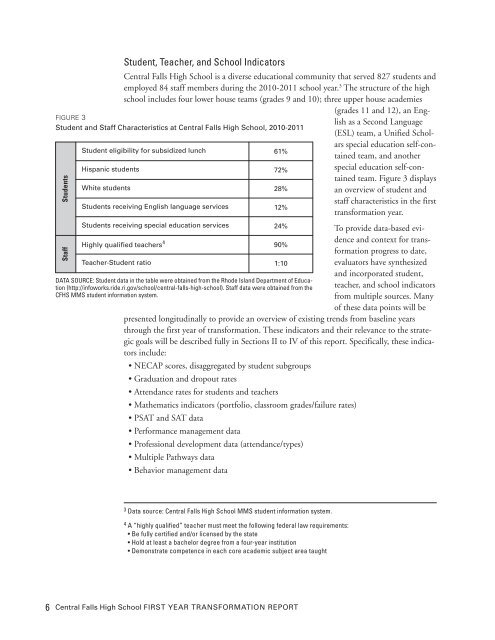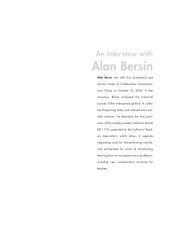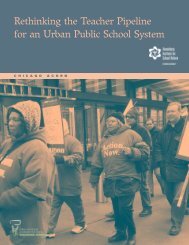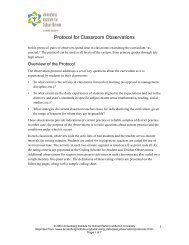Central Falls Transformation Report - Annenberg Institute for School ...
Central Falls Transformation Report - Annenberg Institute for School ...
Central Falls Transformation Report - Annenberg Institute for School ...
You also want an ePaper? Increase the reach of your titles
YUMPU automatically turns print PDFs into web optimized ePapers that Google loves.
Student, Teacher, and <strong>School</strong> Indicators<br />
<strong>Central</strong> <strong>Falls</strong> High <strong>School</strong> is a diverse educational community that served 827 students and<br />
employed 84 staff members during the 2010-2011 school year. 3 The structure of the high<br />
school includes four lower house teams (grades 9 and 10); three upper house academies<br />
(grades 11 and 12), an Eng-<br />
FIGURE 3<br />
Student and Staff Characteristics at <strong>Central</strong> <strong>Falls</strong> High <strong>School</strong>, 2010-2011<br />
Students<br />
Staff<br />
Student eligibility <strong>for</strong> subsidized lunch 61%<br />
Hispanic students 72%<br />
White students 28%<br />
Students receiving English language services 12%<br />
Students receiving special education services 24%<br />
Highly qualified teachers 4<br />
90%<br />
Teacher-Student ratio 1:10<br />
DATA SOURCE: Student data in the table were obtained from the Rhode Island Department of Education<br />
(http://infoworks.ride.ri.gov/school/central-falls-high-school). Staff data were obtained from the<br />
CFHS MMS student in<strong>for</strong>mation system.<br />
6 <strong>Central</strong> <strong>Falls</strong> High <strong>School</strong> FIRST YEAR TRANSFORMATION REPORT<br />
lish as a Second Language<br />
(ESL) team, a Unified Scholars<br />
special education self-contained<br />
team, and another<br />
special education self-contained<br />
team. Figure 3 displays<br />
an overview of student and<br />
staff characteristics in the first<br />
trans<strong>for</strong>mation year.<br />
To provide data-based evidence<br />
and context <strong>for</strong> trans<strong>for</strong>mation<br />
progress to date,<br />
evaluators have synthesized<br />
and incorporated student,<br />
teacher, and school indicators<br />
from multiple sources. Many<br />
of these data points will be<br />
presented longitudinally to provide an overview of existing trends from baseline years<br />
through the first year of trans<strong>for</strong>mation. These indicators and their relevance to the strategic<br />
goals will be described fully in Sections II to IV of this report. Specifically, these indicators<br />
include:<br />
• NECAP scores, disaggregated by student subgroups<br />
• Graduation and dropout rates<br />
• Attendance rates <strong>for</strong> students and teachers<br />
• Mathematics indicators (portfolio, classroom grades/failure rates)<br />
• PSAT and SAT data<br />
• Per<strong>for</strong>mance management data<br />
• Professional development data (attendance/types)<br />
• Multiple Pathways data<br />
• Behavior management data<br />
3 Data source: <strong>Central</strong> <strong>Falls</strong> High <strong>School</strong> MMS student in<strong>for</strong>mation system.<br />
4 A “highly qualified” teacher must meet the following federal law requirements:<br />
• Be fully certified and/or licensed by the state<br />
• Hold at least a bachelor degree from a four-year institution<br />
• Demonstrate competence in each core academic subject area taught













